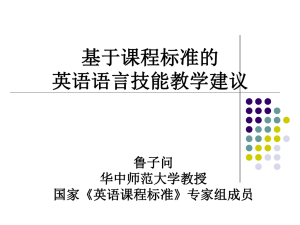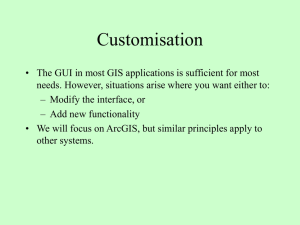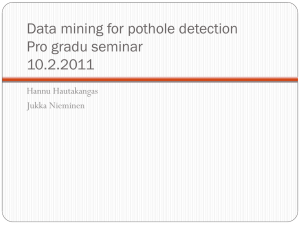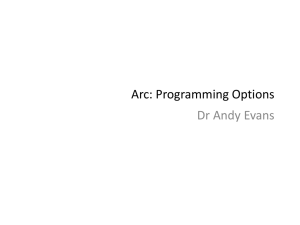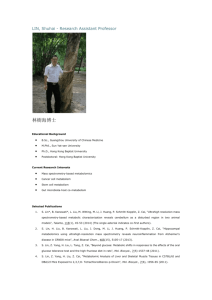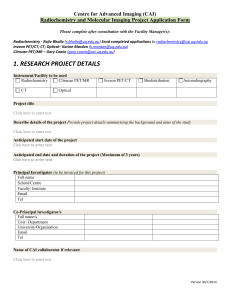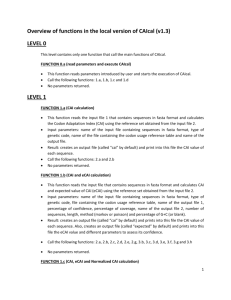Presentation
advertisement
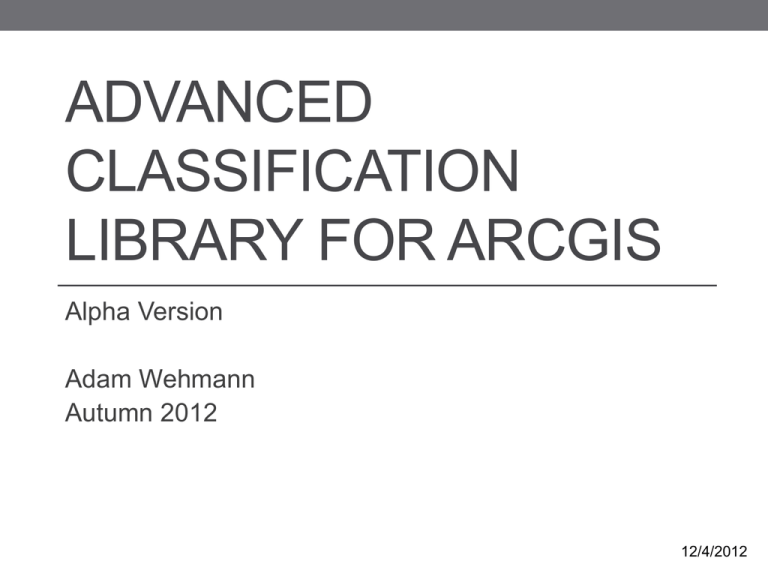
ADVANCED CLASSIFICATION LIBRARY FOR ARCGIS Alpha Version Adam Wehmann Autumn 2012 12/4/2012 Introduction • Esri provides only one supervised classification tool for use in ArcGIS. • Maximum Likelihood Classification (MLC) is available through the Multivariate toolbox in the Spatial Analysis extension. • The classification toolset in ArcGIS is inadequate compared to the current state of image classification technology. Objective • Enhance ArcGIS’s classification abilities by incorporating the ability to perform supervised classification by: • Support Vector Machines (SVM) • Spatial-Temporal Modeling Method (STM) • Liu and Cai 2012 • Provide this ability by creating a classification toolbox. • via Python (NumPy, ArcPy) and ModelBuilder. Support Vector Machines • Background: SVM are a state-of-the art supervised classifier that can consistently deliver superior classification accuracies for remote sensing imagery (Huang 2002, Foody 2004). • Idea: SVM are kernel machines that fit a maximummargin hyperplane to the data in a higher dimensional space. • Objective: Interface LIBSVM with ArcGIS. • LIBSVM is a popular, freely available SVM classification library written in C++ with Python bindings specifically designed to enhance SVM usage among scientific disciplines. Spatial-Temporal Modeling Method • Background: STM is a contextual classification method proposed by Dr. Liu and Shanshan Cai of our department that aims to improve multitemporal classification result. • Idea: from a maximum a posteriori Markov Random Field (MAP-MRF) framework, iteratively update classification labels through the minimization of an energy function incorporating spatial and temporal information. • Although stretching the definition, you might visualize this procedure as a 3D cellular automata utilizing a complex, stochastic decision rule where cells can take one of multiple states. • Objective: Develop and interface classifier. STM Energy Function Assign a pixel p the label L that minimizes the energy U: arg min 𝑈 𝐿𝑝 |𝐿𝑁 𝐿 𝑝 where 𝑈 𝐿𝑝 |𝐿𝑁 𝑝 = 𝑈𝑋 𝑥𝑝 |𝐿𝑝 + 𝑈𝑆 𝐿𝑝 |𝐿𝑁𝑆 𝑝 + 𝑈𝑇1 𝐿𝑝 |𝐿𝑁𝑇1 + 𝑈𝑇2 𝐿𝑝 |𝐿𝑁𝑇2 𝑝 = −𝛽0 ln 𝑃 𝑥𝑝 |𝐿𝑝 −𝛽1 −𝛽2 −𝛽4 𝑈𝑋 spectral energy 𝑈𝑆 spatial energy 𝑈𝑇1 past temporal energy 𝑈𝑇2 future temporal energy 𝑁𝑆 𝑝 𝐼 𝐿𝑝 = 𝐿𝑛 𝑝 𝑃 𝐿𝑝 |𝐿𝑛 𝑝 𝑁𝑇1 𝑝 𝑁𝑇2 𝑝 𝛽𝑖 𝑃 𝐿𝑛 𝑝 + 𝛽3 |𝐿𝑝 + 𝛽5 𝑁𝑇1 𝑝 𝑁𝑇2 𝑝 𝐼 𝐿𝑛 𝑝 ⇏ 𝐿𝑝 𝐼 𝐿𝑝 ⇏ 𝐿𝑛 𝑝 weight 𝑃 … prior probability 𝐿 class label 𝑃(… ) probability 𝑝 pixel 𝐼 𝐿𝑝 = 𝐿𝑝 equality indicator function neighborhood of a pixel 𝐼 𝐿𝑝 ⇏ 𝐿𝑝 exclusion indicator function 𝑁 𝑝 𝑝 Results Project Size • 1 toolbox • 7 tools • 10 scripts • 1045 lines of code Data: Liu 2008 (provided by Shanshan Cai) Future • More testing is needed prior to public release. • Obtaining and producing better testing data will be part of this. • Production of stand-alone scripts using GDAL to load data instead of ArcPy functions. • Further documentation. References Allen, D.W. 2011. Getting to Know ArcGIS ModelBuilder. ESRI Press. Chang, C-C. and C-J. Lin. 2011. LIBSVM: a library for support vector machines, ACM Transactions on Intelligent Systems and Technology, 2(27), pp. 1-27. Software available at: http://www.csie.ntu.edu.tw/~cjlin/libsvm Foody, G.M and A. Mathur. 2004. A relative evaluation of multiclass image classification by support vector machines. IEEE Transactions on Geoscience and Remote Sensing, 42(6), pp. 1335-1343. Huang, C., L.S. Davis, and J.R.G. Townshend. 2002. An assessment of support vector machines for land cover classification. International Journal of Remote Sensing, 23(4), pp. 725-749. Liu, D., M. Kelly, and P. Gong. 2006. A spatial-temporal approach to monitoring forest disease spread using multi-temporal high spatial resolution imagery. Remote Sensing of the Environment, 101, pp. 167-180. Liu, D., K. Song, J.R.G. Townshend, and P. Gong. 2008. Using local transition probability models in Markov random fields for forest change detection. Remote Sensing of the Environment, 112, pp. 2222-2231. Liu, D. and S. Cai. 2012. A spatial-temporal modeling approach to reconstructing land-cover change trajectories from multi-temporal satellite imagery, Annals of the Association of American Geographers, 102(6), pp. 1329-1347. Melgani, F. and S.B. Serpico. 2003. A Markov random field approach to spatio-temporal contextual image classification. IEEE Transactions on Geoscience and Remote Sensing, 41(11), pp. 2478-2487. Tso, B. and P.M. Mather. 2009. Classification Methods for Remotely Sensed Data. Boca Raton: CRC Press.


